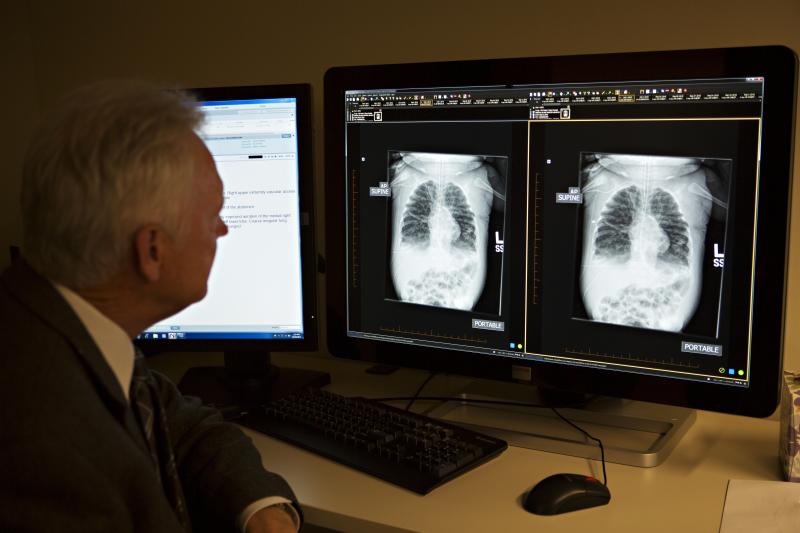
Interviewees: James C. Brown, M.D., director of radiology outreach, associate professor of radiology, University of Missouri-Kansas City School of Medicine; Nanci Burchell, radiation safety officer; Corliss Panis, director of radiology
Children’s Mercy Hospitals and Clinics, one of the nation’s top pediatric medical centers, provides services in more than 40 specialties, including nephrology, oncology, cardiology, heart surgery, orthopaedics, neurology and neurosurgery. Located in Kansas City, Mo., the state-of-the-art 335-bed facility recently purchased a DX-G CR solution that allows it to reduce radiation dose by 57 percent compared to its previous CR system.
The hospital’s 600-plus pediatricians and researchers are actively involved in clinical care, pediatric research and education. In addition to its primary facility, Children’s Mercy serves the community and the greater Midwest with outpatient facilities and outreach clinics throughout the city, county and surrounding communities.
Challenges of Providing Care for Babies Born Prematurely
Neonatal radiography of premature infants is one of the most demanding areas of radiography, according to James C. Brown, M.D., director of radiology outreach and associate professor of radiology, University of Missouri-Kansas City School of Medicine. “Because the patient is so small, radiographic contrast is low and it is difficult to visualize details,” he says. “Yet we still want to use the lowest possible radiation dose because in some cases, premature infants may receive 30 to 40 exposures over the course of their treatment.
“Premature infants are born with a lot of problems,” Dr. Brown goes on to explain. “Their underdeveloped lungs don’t have enough surfactant to breathe on their own, so their lungs must be monitored via X-ray up to three or four times a day. The same goes for babies with congenital heart disease.”
Many radiography systems use technology and processing that limits their ability to reduce dose and improve image quality. In 2012, Children’s Mercy purchased new computed radiography equipment from Agfa HealthCare. The Agfa HealthCare DX-G CR solution has allowed Children’s Mercy to reduce radiation dose by 57 percent compared to its previous CR system.
Ideal for Neonatal and Standard Pediatric Radiography
Children’s Mercy is using the DX-G to process approximately 10,000 neonatal chest X-rays each year. The DX-G combines several innovative technologies and features that allow the radiology department to reduce and better monitor radiation dose: DirectriX CsBr needle-based phosphor detectors, the NX workstation with MUSICA2 Platinum Pediatric image processing, color-coded dose bar, extended dose monitoring analysis and automated repeat/reject analysis.
Side-by-Side Comparison Shows Same Image Quality With Reduced Dose of Nearly 60%
“We did a side-by-side comparison of the DX-G with our previous digitizer, and the outcome was very clear,” says Corliss Panis, director of radiology. “We achieved the same quality in the diagnostic image at a reduction in radiation dose of nearly 60 percent.”
The DX-G includes a deviation index that helps technologists determine if an image is under- or over-exposed with an easy-to-read color-coded (red/yellow/green) dose bar. “The technologists love how easy it is to determine if exposure is correct compared to our previous digitizer,” says Nanci Burchell, radiation safety officer. “It is very simple — you just have to make sure that you stay in the green zone. It is linear, and visual. Before, you saw a number, and the higher the number was, the lower the dose was. It was counterintuitive and confusing.”
Extended Dose Monitoring Analysis Software Marks Industry First
The system incorporates Extended Dose Monitoring software, the first in the industry to use the newly established International Electrotechnical Commission (IEC) exposure index standard. The exposure monitoring results are displayed at the workstation and can be configured as structured reports to detect dose drift within the department or even to monitor the performance of an individual technologist over time. The DX-G also provides an automated method for analyzing and tracking repeat exposures, again allowing the department to monitor departmental or individual performance.
“We can review and measure the performance of the department as a whole, as well as the individual technologist,” explains Corliss. “If there are any outliers, we can work with them to optimize their technique to bring their exposures in line with the department norm.”
“Premature infants are so much more susceptible to the risks of radiation. The DX-G with DirectriX CsBr plates allows us to give them the care they require while lowering the corresponding risk of radiation-induced cancer,” concludes Dr. Brown. “To reduce radiation dose by almost 60 percent and still have the same image quality is a significant step forward for Children’s Mercy and our neonatal patients.”
Solution
DX-G CR solution:
- Bridges the gap between high performance needle detector imaging and traditional phosphor cassettes
- Features DirectriX CsBr needle-based phosphor detectors, with nearly twice the detection quantum efficiency (DQE) of powdered phosphor systems
- Touch screen NX workstation integrates with in-room equipment and other hospital systems to streamline workflow
- MUSICA² Platinum Pediatric image processing offers age-specific image processing for enhanced detail and minimizing image adjustment time
Agfa HealthCare’s Contribution
- Understanding of and adherence to industry regulations and standards
- Industry-leading technology that delivers patient care and efficiency benefits
- Expertise in imaging and hospital workflows and needs
Did You Know…
- For two years in a row, Children’s Mercy has been named as one of the country’s best children’s hospitals by U.S. News & World Report.
- It has also been recognized by the American Nurses Credentialing Center for excellence in nursing services.
- Children’s Mercy Hospitals and Clinics recently opened a new pediatric emergency department to serve the south side of the city, and it was just named as a participant in a national effort to improve the quality of pediatric patient care and safety.
© Agfa HealthCare 2013
DX-G and MUSICA are trademarks of Agfa HealthCare NV, Belgium or its affiliates.
For more information: http://www.agfahealthcare.com



 December 10, 2025
December 10, 2025 









